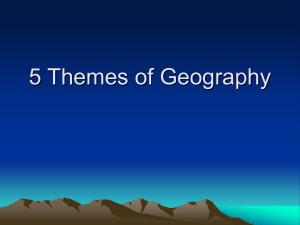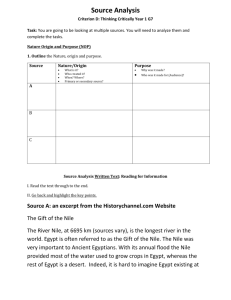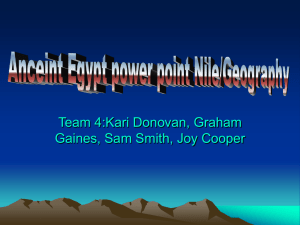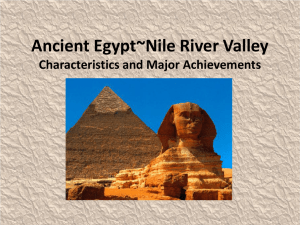Name Period ______ Gifts of the Nile Imagine a deep blue river and
advertisement
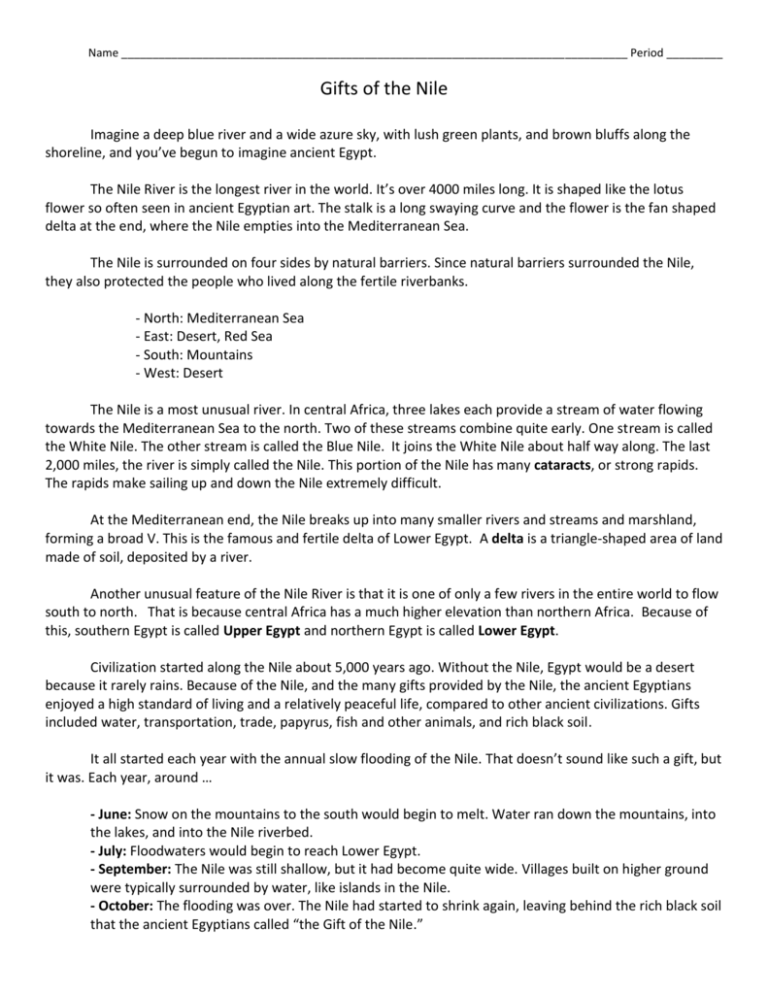
Name _________________________________________________________________________________ Period _________ Gifts of the Nile Imagine a deep blue river and a wide azure sky, with lush green plants, and brown bluffs along the shoreline, and you’ve begun to imagine ancient Egypt. The Nile River is the longest river in the world. It’s over 4000 miles long. It is shaped like the lotus flower so often seen in ancient Egyptian art. The stalk is a long swaying curve and the flower is the fan shaped delta at the end, where the Nile empties into the Mediterranean Sea. The Nile is surrounded on four sides by natural barriers. Since natural barriers surrounded the Nile, they also protected the people who lived along the fertile riverbanks. - North: Mediterranean Sea - East: Desert, Red Sea - South: Mountains - West: Desert The Nile is a most unusual river. In central Africa, three lakes each provide a stream of water flowing towards the Mediterranean Sea to the north. Two of these streams combine quite early. One stream is called the White Nile. The other stream is called the Blue Nile. It joins the White Nile about half way along. The last 2,000 miles, the river is simply called the Nile. This portion of the Nile has many cataracts, or strong rapids. The rapids make sailing up and down the Nile extremely difficult. At the Mediterranean end, the Nile breaks up into many smaller rivers and streams and marshland, forming a broad V. This is the famous and fertile delta of Lower Egypt. A delta is a triangle-shaped area of land made of soil, deposited by a river. Another unusual feature of the Nile River is that it is one of only a few rivers in the entire world to flow south to north. That is because central Africa has a much higher elevation than northern Africa. Because of this, southern Egypt is called Upper Egypt and northern Egypt is called Lower Egypt. Civilization started along the Nile about 5,000 years ago. Without the Nile, Egypt would be a desert because it rarely rains. Because of the Nile, and the many gifts provided by the Nile, the ancient Egyptians enjoyed a high standard of living and a relatively peaceful life, compared to other ancient civilizations. Gifts included water, transportation, trade, papyrus, fish and other animals, and rich black soil. It all started each year with the annual slow flooding of the Nile. That doesn’t sound like such a gift, but it was. Each year, around … - June: Snow on the mountains to the south would begin to melt. Water ran down the mountains, into the lakes, and into the Nile riverbed. - July: Floodwaters would begin to reach Lower Egypt. - September: The Nile was still shallow, but it had become quite wide. Villages built on higher ground were typically surrounded by water, like islands in the Nile. - October: The flooding was over. The Nile had started to shrink again, leaving behind the rich black soil that the ancient Egyptians called “the Gift of the Nile.” - November or December: The land near the riverbank had dried enough so that crops could be planted in the rich black soil. - March and April: Crops were green and ready to harvest. - May: The Nile had become a little stream. The valley had turned brown. If the slow floodwaters did not return, the land would become a desert. - June: The cycle started over again. Snow on the mountains to the south would begin to melt … AGRICULTURE: As the floodwaters rose slowly and predictably around the same time each year, the irrigation ditches the ancient Egyptians had built filled with water. As the water receded, the farmers blocked the irrigation ditches to keep the water inside, water they used to help them grow crops in the rich black soil. They grew figs, onions, pomegranates, apples, beans, garlic, chick peas, radishes, spinach, turnips, lettuce, carrots, cucumbers, melons, pumpkins, grapes, barley (used to make bread and beer) and flax (used to make clothes). The ancient Egyptians also built dams, to keep a supply of water handy in case of drought. INVENTION – Shaduf: They invented the shaduf (pronounced sha-doof) to help them lift water from the canals to the crops. A shaduf is a bucket on a rope that hangs from a frame on a pivot. They dipped the bucket in the water, and spun the shaduf around so they could empty the bucket on the crops. It saved a lot of labor, because they did not have to hand carry water. They used the shaduf to lift the water for them. PASTURELAND: The Nile provided pastureland. Herdsmen and shepherds pastured their animals in the marshes along the Nile. Beef, oxen, sheep, and goats provided meat, milk, hides and dung for cooking fuel. Milk was highly prized, as was butter. FISH & GAME: The Nile was rich with food. Eggs were plentiful. There were ducks and wild geese and quails and water birds, as well as bigger animals like crocodile and hippopotamus. Fish was eaten by the lower classes. DRINKING WATER: The Nile was a river, not a salty sea. That meant the ancient Egyptians could drink the water, wash their clothes, and bathe (which they did daily). PAPYRUS: Along the Nile, a plant called papyrus grew wildly along the riverbanks. The ancient Egyptians used papyrus to make paper, to build boats, to make sandals for their feet, and to make baskets to store their belongings and to carry their food. Boats were made out of papyrus because wood was scarce. TRANSPORTATION & TRADE: The Nile provided an easy, cool transportation route. It was a major trade route. The ancient Egyptians had cargo boats, passenger boats, funeral boats, and naval vessels. The prevailing wind along the Nile blows south and the current flows north. The ancient Egyptians hoisted sails on their boats to sail upstream, and used the Nile’s natural current to help them boat downstream. This made travel up and down the Nile very easy! BUILDING MATERIAL: The Nile provided not only rich deposits of black soil, but also created rich deposits of clay, granite, sandstone and limestone used for building. The ancient Egyptians built their homes out of stone and clay, not wood. Wood was scarce. THE ARTS: You can imagine what a worry it was – would the Nile flood again this year? The Nile was incredibly important to the ancient Egyptians. They sang songs and created myths and stories to honor and to explain the wonderful Nile. They were very grateful for all her many gifts. Here is an example of a poem written to praise the Nile: When the Nile is sluggish, the nostrils are stopped up and the people are brought low, The offerings of the gods are reduced and millions die. When the Nile rises, the Earth is joyous and everyone is glad, Every jaw laughs and every tooth is uncovered. Directions: Answer the following questions using POQ (Complete sentences!) 1. Where is Lower Egypt located? Where is Upper Egypt located? 2. What are cataracts? 3. What is a delta? 4. How were people protected in Ancient Egypt? 5. What are three Gifts of the Nile River other than rich soil?



